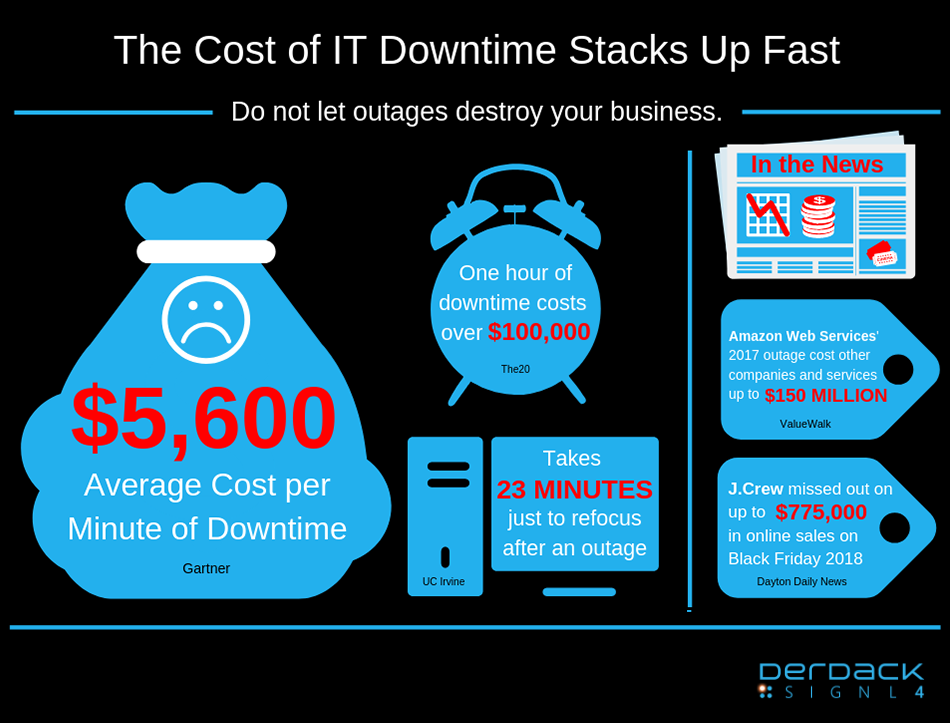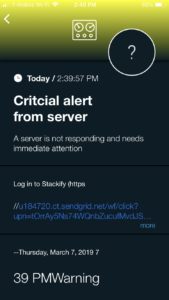IT downtime can effect businesses of all sizes. From online retailers and event promoters to cloud-based service providers and 24/7 security teams, all modern businesses are at risk of facing both monetary and organizational costs that can stack up in a matter of minutes. Users (internal and external) may not be able to access websites and files, digital transactions may be delayed, data may be lost, and sensitive information may be compromised, which can make for a very bad day at the office. It is critical that teams not only work to prevent such outages, but they should also have a reliable method to alert internally of any IT downtime that occurs, so that issues can be remedied as soon as possible. In this article we will dive into IT downtime costs as well as what preventive measures you can take with SIGNL4 to make sure that your business’ IT infrastructure is up and running around the clock.
The costs associated with IT downtime
Say it is a busy time of year for your company. There is slightly higher traffic on your costumer-facing site and your team is already aware of some recent developing security risks. Next thing you know, you are down. Your site and some of your systems are now offline. No one knows why, but your company is now in a state of emergency while your IT staff scrambles to identify the root of the issues. Costs are almost an afterthought in this moment, but they will soon be realized. To put it simply, things are not good.
Allow me to put this situation into more quantitative terms. The average cost of IT downtime for a larger company is approximately $5,600 per minute according to Gartner. For Facebook you are looking at about $24,420 lost per minute. When looking at hours of downtime, a company could be facing costs anywhere from $140,000 per hour to $300,000 per hour… and even as much as $540,000 an hour for a company. This is additionally backed up by the claim that 98% of organizations say a single hour of downtime costs over $100,000 on The20. Beyond the monetary recovery costs of IT downtime, a company’s operational efficiency will be heavily effected as well. A study conducted by UC Irvine found that it takes 23 minutes on average to refocus a workforce after an outage. There could be as much as $128,800 (or more!) lost before a team begins troubleshooting an issue. IT downtime is not something business leads can ignore.

Beyond money – your reputation is at stake
Besides direct costs there are some other things at stake when your IT infrastructure is negatively effected. For example, companies like Walmart, J.Crew, and GameStop all experienced severe downtime on Black Friday last year. J.Crew’s outage reportedly cost the company up to $775,000 in sales. Those sales lost likely went right to their competitors offering similar high-end products at comparable discounts. With the boom in e-commerce, there is simply no way to make up for that. People are looking to spend their money when they have it, and if they have to wait to make a transaction, they are going to go elsewhere. IT downtime hits even harder when your competitors begin to make money off a situation you did not expect.
Sure, you may lose money in a retail or e-commerce space in an outage event, but what happens when your a service provider and your customers are effected internally as well? Salesforce recently reported a “major issue” that caused customers to lose access to popular services Sales Cloud and Service Cloud. It is bad enough when a website is down, but it is even worse when your customer’s business is brought to an immediate halt when the services they rely on are out. No one likes handling an issue that is simply out of their control. Although their CEO has gone on the record to say they are the fastest growing software business in history, scaling at such a rate is risky. This 15-hour outage likely resulted in major consequences for Salesforce. In addition to restoring their software to customers, they probably had to pay-out penalties to customers due to business lost and SLA’s missed. Amazon faced a similar issue where their Amazon Web Services (AWS) had a prolonged outage in 2017. AXIOS estimated that the downtime cost other companies and services up to $150 million in related damages and lost business. Some customers may have been affected more than others, and they may be looking to work with a different provider from now on, which can hurt Salesforce even more in the long run. IT downtime does not only cost money, but it can certainly cost your reputation as well.
How critical alerting can mitigate the impact of an IT outage
It is best to be safe than sorry when dealing with IT threats and unforeseen system errors. By 2021, it is predicted by Gartner that 65 percent of infrastructure and operations (I&O) leaders will underinvest in their availability and recovery needs. I would like to think that you would not like to be a part of that statistic. At the very least, businesses should want to know exactly where and when critical outages occur in their IT infrastructure. SIGNL4 can be a great first step towards monitoring and preventing IT downtime in your business.

SIGNL4 is a mobile SaaS solution built for operations teams across many industries. Whether you are a manufacturer, a service provider, or an emergency responder, chances are you actively monitor some aspect of your business for events that may disrupt or drive your business. SIGNL4 pairs with your monitoring system of choice to deliver enriched persistent alerting to mobile teams, so you know exactly when critical events occur. With SIGNL4, teams can be notified immediately of IT downtime, so they can work immediately to troubleshoot an outage. SIGNL4 can help with preventive measures as well by indicating when machines malfunction or when system backup fails before a more catastrophic situation arises. Beyond it’s standard persistent alerting, SIGNL4 is also capable of the following:
![]() Ops team shift scheduling to manage workforce availability
Ops team shift scheduling to manage workforce availability
![]() Escalation parameters for management to ensure incidents are taken care of
Escalation parameters for management to ensure incidents are taken care of
![]() Event filtering to avoid false alarms, thus higher attention to critical events
Event filtering to avoid false alarms, thus higher attention to critical events
![]() Visual and acoustic customization of alerts to facility for a quicker response
Visual and acoustic customization of alerts to facility for a quicker response
![]() In-app ChatOps for fast interaction
In-app ChatOps for fast interaction
![]() Incident alert tracking to follow resolution progress
Incident alert tracking to follow resolution progress
![]() And plenty more!
And plenty more!
By using a simple webhook or writing few lines of code users can integrate their favorite IT monitoring tools with SIGNL4 to push real-time critical alerts to their operations teams. See our integrations page for a full listing of the application connections we have already highlighted. Do you work with a software that we do not include in our integrations page? Let us know via our live chat client (bottom right corner) or shoot an email to [email protected] to get in touch.
Do not let IT downtime take down your business
Take a look at your current operations. Are you doing everything you can to either prevent or properly react to an incident that could lead to a potential outage in your organization? If you are looking to add a lightweight tool to assist in your battle against downtime, consider giving SIGNL4 a test ride. Download it for free today on your mobile device, and pair it with your software of choice. If you like it enough take a look at our pricing offerings, and figure out what plan works best for your team. We are more than happy to help if you have any questions.
[cv_special_header text=”Assemble your SIGNL4 team today!” align=”center” size=”normal” margin=”0″][/cv_special_header]
*Sign up free, no Credit Card required



